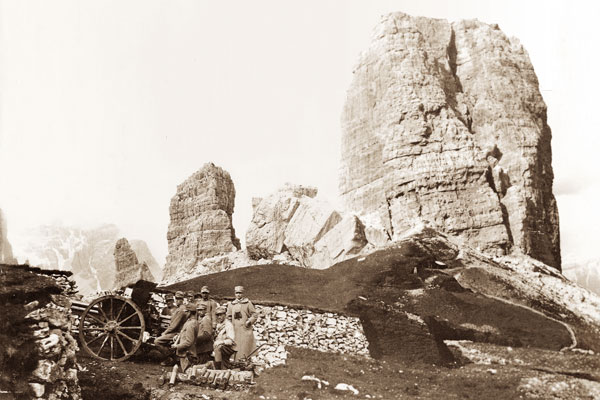- TIPS
- SUMMER
- WINTER
- HOSPITALITY
- HISTORY AND MUSEUMS
- INFO
- VIDEO
- DELICIOUS APP

Photo by Stefano Zardini
- TIPS
- SUMMER
- WINTER
- HOSPITALITY
- HISTORY AND MUSEUMS
- INFO
- VIDEO
- DELICIOUS APP

Photo by Stefano Zardini
Since the very beginning of the First World War, when the Italian Army was advancing towards Val Badia along the Great Dolomites Road from Cortina to the Falzarego pass, the strategic importance of the 5 Torri area was immediately clear.
Most important of all, was the observatory at 2477 m of height on Mt. Nuvolau, dominating Falzarego, Val Cordevole, upper Val Costeana and Val Badia; it was a sort of "window" open onto Col di Lana, Sief, and Settsass.
All the movements of the troops located in this wide zone could be followed from this top.
The Italian Army took up positions in the 5 Torri area at the beginning of June 1915; the troops were arranged in holes excavated beneath the rocky walls or wherever sheltering was possible. A hard and difficult work started immediately; trenches and emplacements were built and telephone lines and field telegraph, warehouses for food and munitions, shelters for the animals and barns were arranged.
Here were set up the Headquarters of the Italian mountain artillery group; gigantic Navy cannons, which could shoot shells 30 cm in diameter, were brought up.
The 4th Battery operated at the 5 Torri and her main objectives were Sasso di Stria, Valparola, Lagazuoi and Falzarego while the 5th Battery was oriented towards Falzarego and Col dei Bos.
At the headquarter of the siege artillery a department for the observation service was set up. Each station was equipped with goniometers, field glasses and long-range binoculars, a mapping section, updated target lists by the fire control office, batteries, observation posts, and strongholds.

Each squad had an observation post to check the accuracy and effectiveness of their artillery during the bombardment.
The observers also had the task of identifying new targets which required artillery actions. The artillery at 5 Torri immediately knocked out the Tre Sassi Fort at the Valparola pass and forced the Austro-Hungarian soldiers to abandon the fort.
The developments in cannon technology had once again overcome the resistance of the armouring aimed to protect the fortresses.
The Great War in the Cinque Torri area left kilometres of trenches, and various machine gun and artillery emplacements.
This defence line was meant to hold back enemy penetration if the front line at the Falzarego Pass was breached by the Austro-Hungarian troops.
Armoured trenches for kneeing soldiers with a covering layer capable of resisting fusillades were conceived.
The other fundamental function of the covered trenches was to guarantee the protection of observers, who followed the events along the battle line.
Photographers and artists observed the slightest changes along the enemy lines, supplying the Headquarters constantly with the latest developments.
For information about the 5 Torri WW1 open-air museum, click here.
